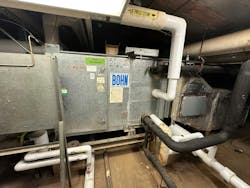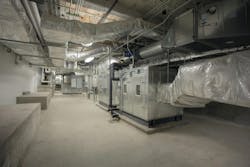Facility Condition Assessment Data Can Help Reduce Carbon Footprint
The increasing impacts of climate change are driving a global urgency for carbon neutrality. Today, 11 states have mandated a 100 percent goal for both renewable portfolio standards, carbon emission portfolio standards, and greenhouse gas reduction standards. Nine have no current legislative mandates, with the balance having various degrees of commitment up to 75 percent by 2050 or sooner, according to the National Regulatory Research Institute. The intent of these goals or mandates is to effectively reduce net carbon emissions to various levels and help mitigate the worst impacts of climate change, such as multi-billion dollar weather events, rising sea levels, air quality, and ecological disruptions.
In facility ownership and management, it's essential to recognize the responsibilities and opportunities that come with this sense of urgency. Buildings and facilities significantly contribute to carbon emissions through energy consumption for heating, cooling, lighting, and operating equipment. In fact, the International Energy Agency estimates that buildings are responsible for nearly 40 percent of global carbon dioxide emissions.
Every step taken to make your facility more sustainable and reduce carbon emissions contributes to the collective effort to fight climate change. Your portfolio is more than just space—it plays a vital role in the global ecosystem. By optimizing energy use, adopting sustainable practices, and investing in green technologies, you not only enhance the resilience of your facility but also contribute to the health and well-being of the planet.
To achieve carbon neutrality in facility management, strategies to reduce energy consumption, improve energy efficiency, reduce total energy load requirements, and transition to renewable energy sources must be implemented. Additionally, the carbon footprint must be considered at every stage of the facility’s lifecycle, including construction, material usage, energy use, waste management, water consumption, adaptive reuse, and end-of-life (demolition).
A facility owner and management team are pivotal in this transition. Organizations can significantly reduce their carbon footprint by conducting comprehensive facility condition assessments (FCAs) with a dedicated focus on resiliency, decarbonization, and implementing sustainable practices. This contributes to the overall effort to mitigate climate change and often results in operational cost savings, compliance with increasingly stringent environmental regulations, and an enhanced reputation for corporate responsibility. Thus, the drive for carbon neutrality becomes a strategic business decision, aligning with operational and global sustainability goals.
A detailed FCA harnesses powerful data collection, analysis, and management tools and provides the foundation for sound decision making. This involves understanding energy sources, documenting fuel-burning equipment, identifying inefficiencies, prioritizing replacement timeframes, implementing energy-saving measures, planning for necessary upgrades or replacements, and facilitating the transition to renewable sources. The FCA can lead to a comprehensive plan in which various strategies can be applied to different facility systems. Typically, FCAs will unearth and provide cost estimates for hundreds or even thousands of deferred maintenance items. The goal is to have the right data markers to separate the signals from the noise and bring projects to the forefront that will qualify for multiple funding streams and advance institutional goals or mandates.
Let’s look at some example outcomes or scopes, from electrical to structural systems, that might be identified to reduce emissions and promote sustainability. The first three examples illustrate a two-pronged approach to decarbonization, that is, reducing the loads and replacing them with more efficient systems.
Electrical Systems
- Motors in industrial and commercial facilities often contribute to a large portion of energy consumption. Upgrading to energy-efficient motors can result in substantial energy savings. This efficiency reduces the building’s overall electric consumption, thereby lowering its carbon footprint. An FCA can tell you when the right time to do this would be to get the most out of your initial investment and ‘replace smart.’
- Smart control systems enable more precise and efficient energy management. These systems can automatically adjust lighting, heating, cooling, and ventilation based on real-time occupancy or predetermined schedules. Smart controls reduce unnecessary energy consumption, thus decreasing the carbon emissions associated with energy use. This is especially true based on changing workplace methodologies in the last five years. This data ties energy usage to capacity and use and is extremely valuable.
- Of course, LED lighting is a consequential advancement in energy efficiency compared to traditional incandescent and fluorescent bulbs. LEDs use significantly less energy for the same level of lighting output, translating into lower energy bills and reduced carbon emissions.
Energy-Efficient Boilers, Chillers, and Ventilation Systems
- Modern, energy-efficient boilers have higher efficiency rates, meaning they use less fuel to produce the same amount of heat. Upgrading a boiler can reduce fuel consumption and lower carbon emissions.
- Energy-efficient chillers use advanced compressors and heat exchange techniques to cool a building more efficiently. They often have variable-speed drives that adjust cooling output to current needs, avoiding energy waste.
- Ventilation systems with energy recovery units significantly reduce energy usage by recovering heat or cooling from exhaust air and using it to condition incoming fresh air.
Architectural and Structural Systems
- Low-emission glass reduces the amount of infrared and ultraviolet light passing through windows without affecting visible light. As a result, this glass improves insulation and reduces energy needs for heating and cooling.
- High-quality insulation helps maintain stable interior temperatures, which lowers the energy required for heating and cooling.
- Green roofs provide insulation, help manage stormwater, and absorb carbon dioxide, contributing to a building's sustainability.
Water-Efficient Plumbing Fixtures
- Low-flow fixtures like faucets, toilets, showerheads, and waterless urinals incorporate advanced technologies to minimize water usage while maintaining performance. For example, low-flow toilets reduce water usage per flush, while waterless urinals eliminate the need for water altogether.
- Decreasing water consumption can lead to reduced energy consumption, particularly in cases where water heating is involved, further contributing to lower carbon emissions.
Environmentally Friendly Fire Suppression Gases
- Traditional fire suppression systems often use chemicals that are harmful to the environment. By switching to environmentally friendly fire suppression gases such as FM200 or Novec 1230, facilities can effectively suppress fires while minimizing environmental harm. These gases have zero ozone depletion potential and much lower global warming potential than traditional fire suppressants.
Emergency Systems
- Modern standby power systems are designed to be more energy-efficient. They minimize fuel consumption through advancements such as improved engine designs and variable speed drives that match power output to current needs.
- Many modern systems use cleaner fuels, such as natural gas or hydrogen blends, to reduce emissions. Smart management systems optimize performance, ensuring peak efficiency and reduced run time.
Proactive Steps on the Path to Sustainable Facility Management
As we progress toward a more sustainable and efficient future in facility ownership and management, the role of facility managers, engineers, and decision-makers becomes increasingly crucial. Reducing carbon emissions is not just a trend, but rather an essential shift in the future of our built environment with aggressive mandates across the country. Here are some proactive steps to take:
- Assess and plan: Begin by conducting a comprehensive facility condition assessment (FCA). Utilize appropriate software solutions that can capture this data meaningfully to evaluate your facility’s current status and pinpoint opportunities for enhancing energy efficiency, water conservation, and sustainability.
- Embrace emerging technologies: Explore and invest in ‘smart’ technologies for building management. These can enhance operational efficiency and reduce environmental impact.
- Educate and train: Ensure your team is trained on the latest sustainable practices and technologies to implement new strategies successfully.
- Monitor, report, and improve: Use data analytics to monitor performance, report progress regularly, and identify opportunities for improvement.
- Share your success stories: Advocate for sustainable practices by sharing your experiences and successes, inspiring others to join the journey toward sustainability.
Facility Optimization Solutions (FOS) specializes in conducting comprehensive FCAs, which are essential for understanding the current state of a facility's infrastructure. By identifying areas that need improvement, FCAs provide a roadmap for making facilities more energy-efficient and environmentally sustainable. By leveraging advanced data analytics, FOS helps facility managers gather and analyze critical information about their buildings. This data is instrumental in making informed decisions about upgrades and improvements that can reduce a facility's carbon emissions. For example, by examining existing energy systems, FOS identifies areas where energy consumption can be reduced.
FOS recognizes that each facility is unique, so we offer tailored solutions. This includes capital planning and forecasting future needs to ensure that facilities not only achieve carbon neutrality in the short term but also maintain and improve upon these standards over time. For more information on ways FOS can assist you, reach out to: [email protected].
FOS Mechanical Assessor Jaime Nantka, FMP, SFP, contributed to this post. With more than 14 years of in-field experience with electrical, plumbing, and maintenance systems, Jaime is highly adept at facility condition assessments. His skillset allows him to reduce repair costs, perform preventative maintenance planning, and recommend energy conservation measures.




